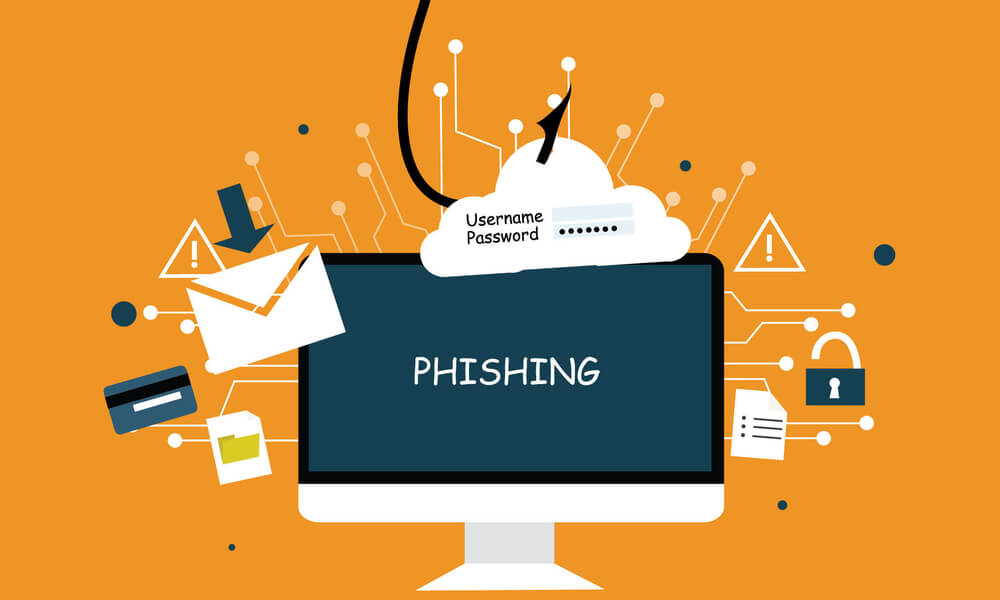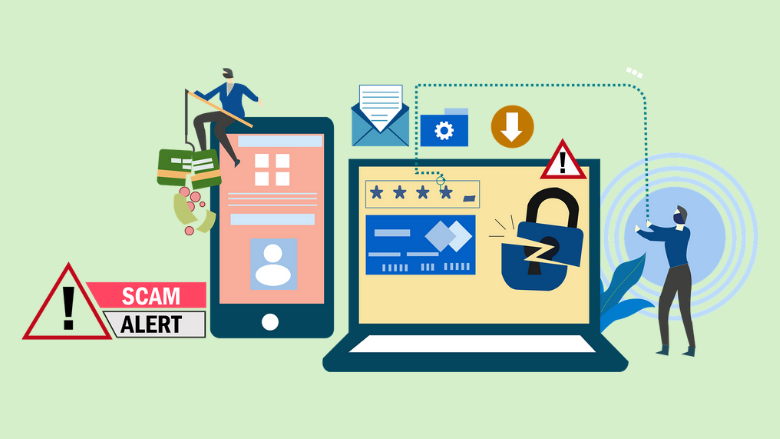If you got another email today claiming you won the lottery or inherited money from a long-lost relative. Maybe it seems too good to be true. You’re smart to be suspicious – it’s likely a phishing scam. Phishing is when cybercriminals try to trick you into giving up personal information or downloading malware by sending fraudulent messages that appear to come from a reputable company or website.
You’ve probably heard of phishing before, but do you know all the sneaky ways scammers try to reel in their victims? In this article, we’ll explore the different phishing techniques scammers use and provide real-world examples so you can better spot and avoid these malicious messages.
What Is Phishing?
Phishing is a cyber-attack where scammers use email or malicious websites to steal your personal information like passwords, account numbers, or credit card numbers. The scammers disguise themselves as a legitimate company or website to trick you into providing sensitive data.
Once scammers have your info, they can access your accounts, make purchases in your name, or commit identity theft. Phishing scams have become increasingly sophisticated, so it’s important to be on alert.
Common signs of a phishing email or message include:
- Urging you to act quickly or provide info immediately
- Poor grammar or spelling errors
- An unbelievable offer, deal, or reward
- A sender’s address that doesn’t match the company name
Legitimate companies will never ask for sensitive data via email. If something sounds off, it’s best to delete the message.
Some well-known phishing techniques include:
- Spear phishing: Targeted attack aimed at a specific person or company. Scammers use personal info to gain trust.
- Whaling: Spear phishing aimed at high-level executives or “big fish”. Scammers pose as a colleague or client to steal corporate data or funds.
- Smishing: Phishing via SMS text message instead of email. Messages appear to be from banks, carriers, or delivery companies to get account numbers or one-time passwords.
- Vishing: Phishing over the phone. Scammers impersonate tech support, bank reps, or government agencies to trick people into providing account access or transferring funds.
Common Phishing Techniques and Attack Vectors
Phishers use clever techniques to trick you into giving them your personal information. Be on guard for these common phishing attack vectors:
1. Emails
The most common phishing tactic is fraudulent emails pretending to be from a legitimate company. These emails often claim there’s an issue with your account or payment information to prompt you to click a link or download an attachment. Never click links or download attachments from unsolicited emails.
2. Text messages
Phishing texts, or “smishing”, claim there’s an issue with a delivery or your bank account to get you to click a link or call a number. Like emails, never click links or call numbers from unsolicited texts.
3. Phone calls
“Vishing” uses phone calls from fraudsters posing as representatives from your bank, credit card issuer, or technology providers. They may claim there’s fraudulent activity on your account or that your account has been compromised to trick you into giving them your details or account access. Never provide sensitive data or account access over the phone to unsolicited callers.
4. Malicious websites
Phishing sites are fraudulent websites made to imitate legitimate sites to steal your login details or account information. Double-check the URL to make sure it’s the correct website and that it uses a secure HTTPS connection before entering any sensitive data.
5. Public Wi-Fi networks
Public networks are a prime spot for “man-in-the-middle” attacks where phishers snoop on the network traffic to steal your data. Never conduct banking, shopping, or other activities that require personal information on public Wi-Fi.
Real-World Phishing Scam Examples
Phishing scams come in all shapes and sizes, but here are a few common real-world examples to watch out for:
1. Email from a “Nigerian prince”
This is a classic scam where you receive an email claiming that a Nigerian prince or other official needs help accessing his fortune, and will share it with you if you provide money or account access. Delete these emails immediately.
2. “You’ve won a prize!”
You get an exciting message that you’ve won a contest or lottery you never entered. To claim your prize, you just need to pay taxes or fees upfront. Don’t fall for it—legitimate sweepstakes don’t ask you to pay to receive winnings.
3. Fake invoice or bill
You receive an email with an invoice or bill for a product or service you never purchased. The scammers are hoping you’ll pay it without verifying. Double-check with the company that supposedly sent the bill before sending any money.
4. “Your account has been compromised”
You receive an urgent message claiming there was a login to your social media, email, or other account from an unrecognized device. The message asks you to click a link to verify your identity and re-secure your account. Don’t click—this is a scam to steal your login credentials.
5. Job offer out of the blue
You receive a message offering you a job, often with a big salary and flexible hours. To get started, all you need to do is provide personal information like your Social Security number or pay an upfront fee for materials or training. This is a fraud—legitimate companies don’t hire people this way or ask for sensitive data right off the bat.
Staying vigilant and learning to spot the signs of fraud can help you avoid becoming a victim. Remember, if something sounds too good to be true, it probably is. When in doubt, trust your instincts.
What is whale phishing?
Whale phishing targets high-profile victims like celebrities, politicians, and business executives. Since these “whales” often have access to sensitive data and large financial resources, they are lucrative targets for phishing scams.
Attackers will gather personal information about the whale from public sources to create a customized phishing email. For example, they may mention the target’s family member by name or reference a hobby or interest to appear more legitimate. These highly personalized phishing emails are more likely to fool the recipient into thinking the message is genuine.
Some examples of whale phishing techniques include:
- Emails appearing to be from the target’s bank, advisor, or accountant requesting private account access or wire transfers.
- Spear phishing emails with malicious attachments or links tailored to the recipient’s interests.
- Impersonation of family members or friends in need of emergency funds or account access.
- Targeting personal or work accounts with the goal of account takeover or installing spyware.
How to Identify and Avoid Phishing Attacks?
Phishing attacks are getting more sophisticated, but there are a few telltale signs that can help you identify them.
1. Suspicious Sender
If an email claims to be from a company you do business with but the sender’s address looks off, that’s a red flag. Legitimate companies don’t change their email domain names frequently. Be wary of messages from free email services like Gmail or Yahoo on behalf of a reputable company. Call the company directly to verify.
2. Pressure to Act Quickly
Phishers want you to act before you have time to verify the message’s claims. Messages that insist you must click a link or download an attachment immediately are probably phishing attempts. Legitimate companies don’t pressure you to bypass security measures.
3. Links and Attachments
Never click links or download attachments from unsolicited messages. Even if the message looks authentic, phishing links can install malware or steal your personal information. Instead, manually enter the company’s website URL into your browser or do a web search to find their official website.
4. Requests for Personal Information
Legitimate companies don’t ask for sensitive data like passwords, social security numbers, or bank account numbers via email. If a message asks for this type of information, it’s likely a phishing scam.
5. Spelling and Grammar Mistakes
While not always the case, phishing emails often contain spelling, grammar, and punctuation errors. Reputable companies usually have professional copywriters and editors to craft error-free communications. Poor writing quality can indicate an amateur phishing attempt.
Protecting Yourself and Your Organization From Whale Phishing
Unfortunately, phishing attacks are becoming more and more sophisticated. While individuals and organizations can’t eliminate the risk, there are several steps you can take to reduce your vulnerability.
1. Be suspicious of unsolicited requests
Never provide sensitive information in response to an unsolicited phone call, email, or text. Legitimate companies will not ask for passwords, Social Security numbers, credit card numbers, etc. out of the blue. When in doubt, contact the company directly instead of clicking links or calling numbers provided in the message.
2. Slow down and be wary of urgency
Scammers often try to create a sense of urgency to get people to act quickly before thinking. Take a step back and consider the logic of the request objectively before responding or clicking anything. Ask yourself if it makes sense for the company or person to be asking for that information or demanding immediate action.
3. Double-check links and spelling
Carefully check the sender’s email address and URLs in messages for slight misspellings or other signs of spoofing before clicking. Malicious links may look very similar to real ones. It’s best to manually type web addresses into your browser instead of clicking links in unsolicited emails.
4. Use strong passwords and two-factor authentication
Make sure all your accounts, especially email, banking, and social media, have strong, unique passwords. Enable two-factor authentication whenever available to add an extra layer of security. Two-factor authentication helps prevent attackers from accessing your accounts even if they obtain your password.
5. Stay vigilant and get training
Cybercriminals are always developing new techniques, so individuals and organizations must stay up-to-date with the latest phishing trends and best practices. Provide regular cybersecurity awareness training for all staff, especially those with access to sensitive data or accounts. With education and vigilance, we can all do our part to foil the phishers.
Conclusion
So there you have it, now you know what phishing attacks are and how to spot them. Don’t let scammers trick you into giving up sensitive info or downloading malware. Stay vigilant, think before you click, and trust your instincts.
If something seems off about an email or text, it probably is. Delete anything suspicious and certainly never enter passwords, account numbers, or send money. You’re too smart to fall for phishing scams and by sharing this info with friends and family you can help inoculate others.



